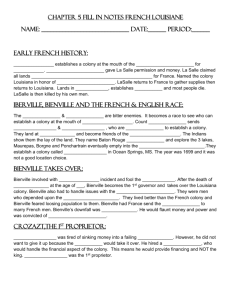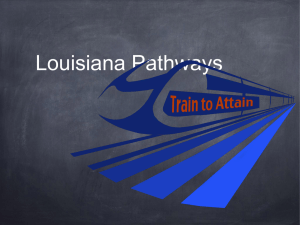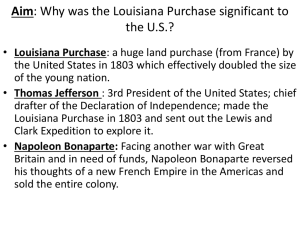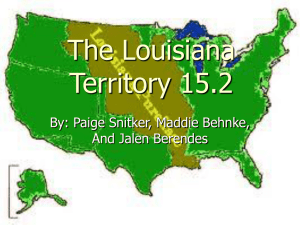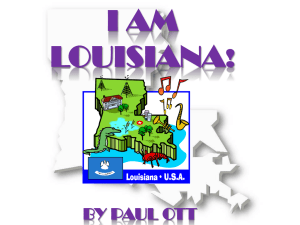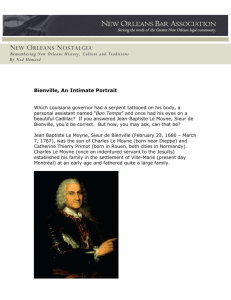Louisiana: Our History, Our Home
advertisement
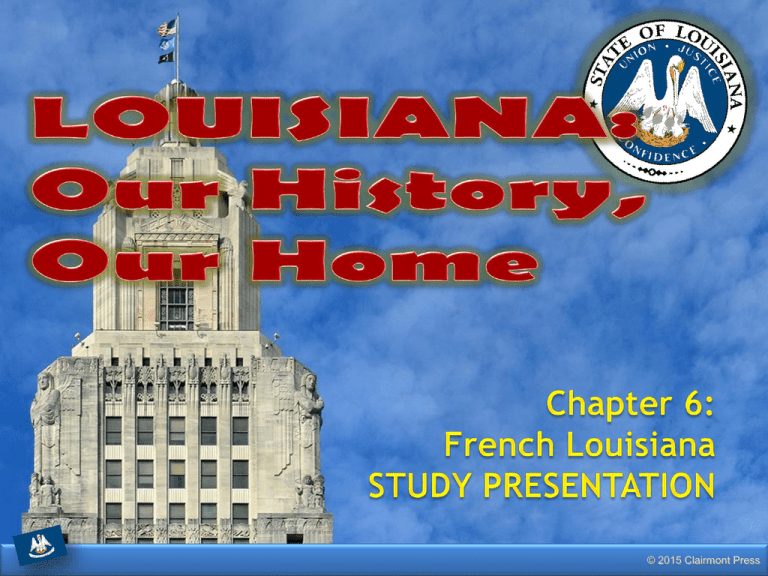
© 2015 Clairmont Press Section 1: Explorations and Early Settlements Section 2: Governing From Afar Section 3: The Founding Generation 2 Section 1: Explorations and Early Settlements Essential Question: • What were the challenges that faced the first French settlements in Louisiana? 3 Section 1: Explorations and Early Settlements What terms do I need to know? • mouth • commandant • commissary-commissioner 4 Introduction The first Europeans in Louisiana were Spanish explorers: Alonso Alvarez de Pineda and Hernando de Soto. The Spanish lost interest in the area when no gold or silver could be found. 5 La Salle’s Return and Death The French, led by René-Robert Cavelier, Sieur de La Salle, wanted to find trade routes to Asia but discovered Louisiana instead. La Salle found the mouth (where a stream enters a large body of water) of the Mississippi River. April 9, 1682- La Salle claimed Louisiana for France and named it after King Louis XIV. La Salle’s efforts to try and return to Louisiana to settle it ended when La Salle’s own men ambushed and killed him on March 19, 1687. 6 Iberville and Bienville Twelve years after La Salle’s death, the French were forced to act on their claim when the Spanish built a fort and settlement at Pensacola Bay near the Mississippi River. 1698- The king sponsored Pierre Le Moyne, Sieur d’Iberville to settle Louisiana. 7 Iberville’s Initial Voyage In October 1698, Iberville, along with his brother Bienville, left France with four ships. Iberville and his men arrived on the Gulf Coast in January 1699 and established a settlement on Ship Island. Iberville and his men reached the mouth of the Mississippi River on March 2, 1699 and established Point Mardi Gras. 8 The Founding of Fort Maurepas Iberville decided the Gulf Coast was a more promising location for a settlement than the mouth of the Mississippi. Their fort was called Fort Maurepas and was built near present-day Ocean Springs, Mississippi. In May of 1699, Iberville returned to France with the goal of bringing back supplies and more settlers. He left Sieur de Sauvole in charge. 9 Bienville’s Explorations Bienville continued to explore the Mississippi River and learned the languages of Native American tribes. When Bienville encountered an English ship, he told them the French had claimed the entire river and surrounding regions and ordered them to leave. As a result of Bienville’s successful bluff, the spot on the river where this took place is called English Turn. When Iberville returned in January of 1700, he and Bienville established Fort Mississippi 54 miles above the mouth of the river. Statue on Bienville in the state capitol 10 The Move to Mobile Bay In May of 1700, Iberville left for France again and left Sauvole in charge. During the summer of 1701, Sauvole died and Bienville took command. Iberville and Bienville decided to move Fort Maurepas to a new and more favorable site since the soil around Frot Maurepas was too sandy to farm and flooded frequently. The new settlement, Fort Louis, was located near Mobile Bay. Iberville returned to France again in 1702, where he was drafted into military service. He contracted yellow fever and died during his service. 11 Administrative Challenge Bienville was named commandant (officer in command) after his brother’s death and faced many main challenges. The French colonists were dependent on food supplies from France, but the shipments were never enough. Bienville also worked hard to maintain friendly relations with the Native Americans in the area. Bienville also had many disagreements with the commissary-commissioner, who controlled the economic affairs of the colony. Bienville remained commandant until 1713 until a new governor was appointed. 12 Explorations 13 Section 2: Governing From Afar Essential Question: • What were the different methods the French used to govern Louisiana? 14 Section 2: Governing From Afar What terms do I need to know? • • • • • proprietorship indigo calumet joint-stock company Mississippi Bubble 15 Introduction Even though Louisiana was not a source of riches, the French hoped the colony would contribute to national wealth. Under mercantilism, Louisiana sent a steady amount of raw materials, including timber and animal pelts back to France. Despite these exports, Louisiana was still not making a profit so it was time for France to try something different. 16 Proprietorship Louisiana became a financial burden on France, but they wanted to keep it so that the Spanish and English could not lay claim to it. King Louis XIV settled on the idea of a proprietorship. The proprietor was given economic control and a portion of the profits in exchange for sending settlers and upholding French law. The first proprietor was Antoine Crozat who appointed Antione de la Mothe, Sieur de Cadillac, colonial governor. Authority was transferred from Bienville to Cadillac in 1713. Cadillac sought to expand the territory north and west rather than east. 17 St. Denis and the Founding of Natchitoches In 1714, Louis Juchereau de St. Denis established an outpost on the Red River which eventually became the city of Natchitoches. It was illegal for French settlers to trade with the Spanish, but the lack of supplies to the city made it necessary. The Spanish traded cattle, horses and silver while the French traded guns, knives, and medicine. This kind of illegal trade was commonplace in remote outposts, but grew to cities like Biloxi, Mobile, and eventually New Orleans. 18 Reconstruction of Fort St. John Baptiste – Natchitoches Fort St. John Baptiste State Historic Site 19 Problems in the Colony Cadillac was the first to promote the cultivation of tobacco and indigo, a plant used to make a blue dye. He also encouraged colonists to begin small farms to increase the amount of food. Cadillac had many disagreements with his business manager and Bienville. By refusing to smoke the calumet (a ceremonial pipe), Cadillac offended the local Indians, which could have led to war. Crozat recalled Cadillac to France, and eventually surrendered the colony back to the crown in 1717. 20 The Company Era Crozat’s financial losses in Louisiana made it difficult for the crown to find a new proprietor. The king and financier, John Law, named Louisiana a joint-stock company, which allowed people to invest in the colony through stocks. Law created the Company of the West to take charge of Louisiana. In 1718, the Company of the Indies took over Louisiana. 21 A Bursting Bubble Law wanted to use the money generated by stocks to develop Louisiana. In the early years of the Company of the Indies, shares were very profitable and the number of investors grew. The company’s rise in value and investors was nicknamed the Mississippi Bubble. As expenses grew, it became difficult to keep stocks profitable. In 1720, there was difficulty paying back initial investments. Stockholders demanded their money in cash, and Law confessed he could not pay them back. Stock prices fell rapidly and many lost their fortunes, including Law. 22 23 The Founding of New Orleans After Law fled France, the Company of the Indies was reorganized and remained in control of Louisiana throughout the 1720s. In 1718, Bienville was finally allowed to build a city on the banks of the Mississippi River. He named it New Orleans in honor of the Duke of Orleans. The first years were difficult. A hurricane in 1723 destroyed the city’s crops and most of the buildings. Bienville was recalled to France on accusations of mismanagement and spent the next seven years defending himself. 24 Territorial Expansion In 1722, Baton Rouge was established. An outpost that would eventually become Alexandria was founded in 1723. As expansion continued, tensions with the Native Americans grew. The French tried to order the Natchez off of their land, which resulted in an uprising in 1729. The Natchez attacked the colonists. For the next two years, French soldiers fought the Natchez and eventually defeated them. Colonists feared for their safety and many returned to New Orleans. In 1731, the Company of the Indies returned Louisiana to the King of France. 25 The Final Years of French Colonial Rule Louis XVI was crowned in 1722 at age twelve. His advisors continued to help him rule France and in 1723, they asked Bienville to return to Louisiana as its governor. War began after the Natchez uprising and ruined the colony’s economy. Alliances between the French and Native Americans, specifically the Choctaw, had been badly damaged and they believed Bienville could resolve them due to his knowledge of the colony and their language. 26 Trouble with the Chickasaw The Choctaw were old rivals of the Chickasaw, who were allied with the English. The French believed that if the two tribes became allies, they would side with the English. Bienville began a military campaign against the Chickasaw. He paid the Choctaw to fight against them. The English gave weapons and supplies to the Chickasaw. The military campaign was unsuccessful and in 1740 they signed a peace treaty with no clear winner. 27 Bienville’s Final Departure Bienville requested that he be replaced, and a new governor was appointed. He left for France in 1743. Even though Iberville led the first expeditions that resulted in settlements, Bienville is known as the Father of Louisiana since he guided the colony through its most difficult early years and founded New Orleans. 28 The End of an Era In 1743, Pierre François de Rigaud, Marquis de Vaudreuil, was named governor of Louisiana. During his 9 year tenure, he oversaw peace with the Chickasaw and tried to bring French culture to New Orleans. In 1752, Louis Billouart, Chevalier de Kerlerec, was appointed governor. He was an experienced military leader, and tensions between France and England were growing. It was his goal to strengthen the colony’s defenses. 29 The End of an Era (continued) Kerlerec had problems managing the colony and requested to be replaced, but he remained governor until Spain took over in the 1760s. In the last years of French control, France and England went to war. France could not provide Louisiana with adequate supplies, so the colonists resorted to trading with the Spanish and English traders. This created a pattern of ignoring official orders from France when needs could not be met. 30 Section 3: The Founding Generation Essential Question: • Which groups of people contributed to the founding and success of the colony of Louisiana? 31 Section 3: The Founding Generation What terms do I need to know? • concession • casket girls • Code Noir 32 Introduction Convincing people to settle in Louisiana was extremely difficult. The mortality rate was high and many people blamed Louisiana for their financial losses. The number of Europeans in Louisiana was very small until the 1720s. A mixture of German, African, and Caribbean settlers came to Louisiana and made up the majority of the population. 33 The Diversity of Colonists In 1699, the first French settlers from Iberville’s expedition came to Louisiana. They were all male and included officers, soldiers, sailors, Canadians, pirates and a small group of laborers. In 1708, there were less than three hundred colonists and many had been brought there against their will, including about 80 enslaved Native Americans. By this time, there were also a few women and children. The French refused to count the hunters and trappers as settlers in the colony. They spent most of the time in the woods. In 1717, the population was about five hundred people, though Crozat promised to send thousands. 34 The Diversity of Colonists (continued) From 1717 to 1721, John Law sent seven thousand settlers to the colony. Concessions (grants of land) were offered to a few people. They agreed to clear and farm land. Concessionaires needed workers. They offered contracts to laborers called engagés, who agreed to work for a number of years in exchange for passage to Louisiana. Many died before the end of their servitude. Law began the practice of sending prisoners to the colony. This group were called the forçats. Several hundred Germans came seeking refuge from war. They were very productive and established small farms. 35 The Diversity of the Colonists (continued) In 1726, there were about two thousand people but getting women to the colony was still a challenge. A small number of girls was sent from France in 1728. Each girl was given a trunk with all the things needed to start a household. They were called casket girls. Native Americans usually escaped and therefore were not the work force the French had in mind. The first group of slaves from Africa arrived in 1716. Between 1719 and 1721, many Africans were brought to Louisiana for the slave trade. They had great agricultural knowledge and rice soon became an important food in Louisiana. Enslaved Africans were the main work force in the colony in 1724, which led Bienville to establish a Code Noir, which dictated the behavior of both slaves and masters. 36 The Rise of Creole Culture Any child born in Louisiana was called a Creole. When French control ended, the population was between six thousand and seven thousand people, and many were Creole. The first generation of people born in Louisiana saw themselves as culturally French. Establishing a strong French culture was essential to the colony’s success. 37 Image Credits Slide 1: Chris Miceli on Wikimedia Commons, Public Domain; Slide 2: Ken Thomas (alligator); Jillian.E (Chicot State Park); City of Monroe, LA; Albert Herring (Mardi Gras), Lael Butler (pelican); Jesper Rautell Balle (cajun meal); Susan Adams (Chemin-a-Haut State Park) on Wikimedia Commons; Slide 19, Reginald Lankford, Clairmont Press; Image Credits Slide: Edd Prince on Wikimedia Commons; maps copyright Clairmont Press; all others public domain Shown here: Fontainebleau State Park Return to Main Menu 38
